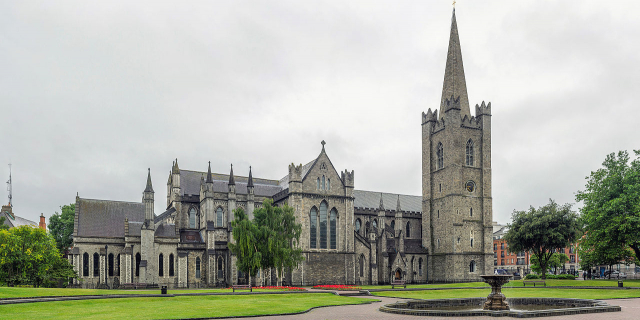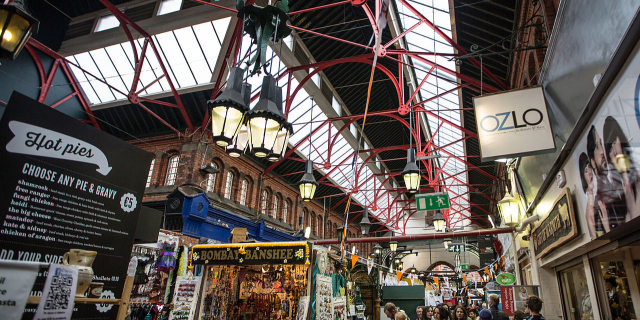Tollymore Forest Park
Tollymore Forest Park was the first state forest park in Northern Ireland, established on 2 June 1955. It is located at Bryansford, near the town of Newcastle in the Mourne and Slieve Croob Area of Outstanding Natural Beauty. It covers an area of 630 hectares (1,600 acres) at the foot of the Mourne Mountains and has views of the surrounding mountains and the sea at nearby Newcastle. The Shimna River flows through the park where it is crossed by 16 bridges, the earliest dating to 1726. The river is a spawning ground for salmon and trout and is an Area of Special Scientific Interest due to its geology, flora and fauna. The forest has four walking trails signposted by different coloured arrows, the longest being the "long haul trail" at 8 miles (13 km) long. It was listed in The Sunday Times top twenty British picnic sites for 2000. The Forest Park has been managed by the Forest Service since they purchased it from the Roden Estate in 1941. ...Read more
Tollymore Forest Park was the first state forest park in Northern Ireland, established on 2 June 1955. It is located at Bryansford, near the town of Newcastle in the Mourne and Slieve Croob Area of Outstanding Natural Beauty. It covers an area of 630 hectares (1,600 acres) at the foot of the Mourne Mountains and has views of the surrounding mountains and the sea at nearby Newcastle. The Shimna River flows through the park where it is crossed by 16 bridges, the earliest dating to 1726. The river is a spawning ground for salmon and trout and is an Area of Special Scientific Interest due to its geology, flora and fauna. The forest has four walking trails signposted by different coloured arrows, the longest being the "long haul trail" at 8 miles (13 km) long. It was listed in The Sunday Times top twenty British picnic sites for 2000. The Forest Park has been managed by the Forest Service since they purchased it from the Roden Estate in 1941.
The name Tollymore (Tulaigh Mhór) is derived from "large hill or mound", referring to the two hills, approximately 250 m high, which are located within the forest boundary. Their official names have been recorded as Slieve Neir (possibly from Sliabh an Aoire, meaning "the mountain of the shepherd") and Slieve Snaran (from either snarvan, meaning to creep, or snarban, meaning a cataract). However, they are more commonly known as The Drinns and Curraghard, meaning "ridge" and "marshy upland" respectively.[1]
After the Norman invasion of Ulster in 1177 and the creation of the Earldom of Ulster, the Magennis clan gained power in the area. The extended Magennis families controlled most of the land in the south of County Down by the 15th century, including the area where Tollymore is located. On 22 February 1611, Tollymore (officially referred to as Ballytollymore) was included in seven and a half townlands which were surrendered to the English crown in return for a formal freehold in the name of Brian McHugh McAghorley Magennis. The land was passed to his grandson in 1628 and when he died without issue in the 1660s, it was passed to Brian Magennis' only daughter Ellen, who was married to William Hamilton of Ayrshire.[1]
Hamilton family Bryansford House, also known as Tollymore Park House (demolished 1952)
Bryansford House, also known as Tollymore Park House (demolished 1952)William Hamilton was from Lecale, County Down, and was a close relative of James Hamilton, 1st Viscount Claneboye, who acquired a large amount of land in County Down a number of years before the Plantation of Ulster. The land was passed to his son James upon his death in 1674.[1]
Tollymore was one of the properties forfeit from the reversal of Cromwellian land settlement and the Act of Settlement 1662 by James II's Patriot Parliament in 1689. This was likely because James Hamilton had raised a regiment in support of William of Orange and was providing the Williamites with supplies. County Down was not involved in the subsequent war.[1]
James Hamilton died in 1701 and Tollymore was passed to his son, James, who became Viscount Limerick in 1719 and 1st Earl of Clanbrassil (second creation) in 1756.[1][2]
The Hamilton family owned Tollymore until James Hamilton, William's great grandson, died in 1798. The estate was transferred to his sister Anne and her husband, Robert Jocelyn, 1st Earl of Roden. The Jocelyn family continued ownership of Tollymore until Robert Jocelyn, 8th Earl of Roden sold it to the Ministry of Agriculture for use in the forestry industry. It was sold in two parts, the first in 1930 and the remaining in 1941.[3]
The seat of the Roden family in Tollymore demesne, known as 'Tollymore Park House' or 'Bryansford House', was a Georgian mansion built initially by James Hamilton, 1st Earl of Clanbrassil (second creation) around 1730, and was demolished in 1952.[4][5][6][7]
During the 1800s, the forest contained five saw mills for processing felled trees. The mills were located on the banks of the Shimna River and powered by water. Millponds stored water, which during dry periods was released to turn the water wheels. The millponds are still located in the forest but are no longer in use.[8]
Between 1994 and 2003, four flint artefacts were discovered in the park, close to the Shimna River. A flake, two blades and a concave scraper were found in two locations the forest. The flake, scraper and one of the blades were identified as prehistoric. The second blade was identified as Late Mesolithic or Early Neolithic. A fifth artefact, a Bronze Age barbed and tanged arrowhead, was found in a nearby field.[9]



































Add new comment